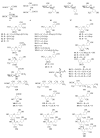Sagan Dalya Tea, a New "Old" Probable Adaptogenic Drug: Metabolic Characterization and Bioactivity Potentials of Rhododendron adamsii Leaves
- PMID: 34072186
- PMCID: PMC8227344
- DOI: 10.3390/antiox10060863
Sagan Dalya Tea, a New "Old" Probable Adaptogenic Drug: Metabolic Characterization and Bioactivity Potentials of Rhododendron adamsii Leaves
Abstract
Adams' rhododendron (Rhododendron adamsii Rehder) or Sagan Dalya tea is a famous Siberian evergreen medical plant of the Ericaceae family used in traditional medicines of Buryats, Yakuts, and Mongols as a tonic, stimulant, and adaptogenic drug. The high popularity of R. adamsii coupled with poor scientific knowledge prompted the addressing of gaps related to metabolic and biomedical data of Sagan Dalya tea. The application of solid-phase extraction and liquid chromatography-mass spectrometric techniques for the metabolomic study of R. adamsii leaf extracts resulted in the identification of more than 170 compounds, including carbohydrates, organic acids, simple phenol glycosides, triterpene glycosides, flavonoids, prenylated phenols, benzoic acid derivatives, hydroxycinnamates, dihydrochalcones, catechins, and procyanidins, most of which were identified for the first time in the plant. Extended surveys of the seasonal content of all detected compounds prove that specific metabolite variations reflect the bioactivity of R. adamsii extracts. Regarding in vitro methods, the expressed antioxidant potential of R. adamsii extracts was investigated via radical-scavenging, nitric oxide scavenging, and ferrous (II) ion chelating assays. The animal-based swimming to exhaustion test demonstrates the stimulating influence of R. adamsii extract on physical performance and endurance, concluding that the drug could act as an adaptogen. Thus, Sagan Dalya tea (R. adamsii) has confirmed its "old" application as a tonic remedy and requires further precise study as a novel adaptogenic plant.
Keywords: Rhododendron adamsii; Sagan Dalya; adaptogen; antioxidant activity; liquid chromatography-mass spectrometry; seasonal variation; swimming to exhaustion test.
Conflict of interest statement
The authors declare no conflict of interest. The funders had no role in the design of the study; in the collection, analyses, or interpretation of data; in the writing of the manuscript, or in the decision to publish the results.
Figures












Similar articles
-
Metabolites of Siberian Raspberries: LC-MS Profile, Seasonal Variation, Antioxidant Activity and, Thermal Stability of Rubus matsumuranus Phenolome.Plants (Basel). 2021 Oct 27;10(11):2317. doi: 10.3390/plants10112317. Plants (Basel). 2021. PMID: 34834680 Free PMC article.
-
Comparative Analysis of Far East Sikhotinsky Rhododendron (Rh. sichotense) and East Siberian Rhododendron (Rh. adamsii) Using Supercritical CO2-Extraction and HPLC-ESI-MS/MS Spectrometry.Molecules. 2020 Aug 19;25(17):3774. doi: 10.3390/molecules25173774. Molecules. 2020. PMID: 32825161 Free PMC article.
-
Identification and quantification of anthocyanins, flavonoids, and phenolic acids in flowers of Rhododendron arboreum and evaluation of their antioxidant potential.J Sep Sci. 2022 Jul;45(14):2555-2565. doi: 10.1002/jssc.202200145. Epub 2022 May 24. J Sep Sci. 2022. PMID: 35569123
-
Traditional uses, phytochemistry, pharmacology, toxicology, and quality control of Rhododendron dauricum L. leaves: A comprehensive review.J Ethnopharmacol. 2023 Apr 6;305:116085. doi: 10.1016/j.jep.2022.116085. Epub 2022 Dec 28. J Ethnopharmacol. 2023. PMID: 36584919 Review.
-
Labrador tea--the aromatic beverage and spice: a review of origin, processing and safety.J Sci Food Agric. 2015 Jun;95(8):1577-83. doi: 10.1002/jsfa.6889. Epub 2014 Sep 29. J Sci Food Agric. 2015. PMID: 25156477 Review.
Cited by
-
Chemistry, biosynthesis, and theranostics of antioxidant flavonoids and polyphenolics of genus Rhododendron: an overview.Naunyn Schmiedebergs Arch Pharmacol. 2025 Feb;398(2):1171-1214. doi: 10.1007/s00210-024-03428-6. Epub 2024 Sep 14. Naunyn Schmiedebergs Arch Pharmacol. 2025. PMID: 39276249 Review.
-
Nose of dog, eye of elk, and wolf's liver: exploring the interconnectedness of Indigenous health and foraging among the Dukha reindeer herders of Mongolia.Int J Circumpolar Health. 2024 Dec;83(1):2343454. doi: 10.1080/22423982.2024.2343454. Epub 2024 Apr 18. Int J Circumpolar Health. 2024. PMID: 38634711 Free PMC article.
-
Metabolites of Prickly Rose: Chemodiversity and Digestive-Enzyme-Inhibiting Potential of Rosa acicularis and the Main Ellagitannin Rugosin D.Plants (Basel). 2021 Nov 20;10(11):2525. doi: 10.3390/plants10112525. Plants (Basel). 2021. PMID: 34834888 Free PMC article.
-
LC-ESI-MS/MS Characterization of Concentrated Polyphenolic Fractions from Rhododendron luteum and Their Anti-Inflammatory and Antioxidant Activities.Molecules. 2022 Jan 26;27(3):827. doi: 10.3390/molecules27030827. Molecules. 2022. PMID: 35164090 Free PMC article.
-
Metabolites of Siberian Raspberries: LC-MS Profile, Seasonal Variation, Antioxidant Activity and, Thermal Stability of Rubus matsumuranus Phenolome.Plants (Basel). 2021 Oct 27;10(11):2317. doi: 10.3390/plants10112317. Plants (Basel). 2021. PMID: 34834680 Free PMC article.
References
-
- Panossian A.G., Efferth T., Shikov A.N., Pozharitskaya O.N., Kuchta K., Mukherjee P.K., Banerjee S., Heinrich M., Wu W., Guo D., et al. Evolution of the adaptogenic concept from traditional use to medical systems: Pharmacology of stress- and aging-related diseases. Med. Res. Rev. 2021;41:630–703. doi: 10.1002/med.21743. - DOI - PMC - PubMed
-
- Dimpfel W., Schombert L., Keplinger-Dimpfel I.K., Panossian A. Effects of an adaptogenic extract on electrical activity of the brain in elderly subjects with mild cognitive impairment: A randomized, double-blind, placebo-controlled, two-armed cross-over study. Pharmaceuticals. 2020;13:45. doi: 10.3390/ph13030045. - DOI - PMC - PubMed
-
- Malyschev L.I., editor. Flora of Siberia, Pyrolaceae-Lamiaceae. Volume 11. CRC Press; Boca-Raton, FL, USA: 2006. pp. 16–19.
Grants and funding
LinkOut - more resources
Full Text Sources

